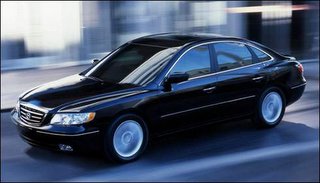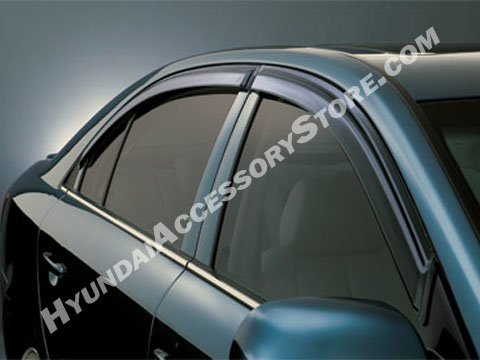Monday, January 30, 2006
GARY ROME HYUNDAI GIVES $10,000 TO THE JIMMY FUND
Friday, January 27, 2006
2006 Hyundai Elantra vs. 2006 Toyota Corolla
Monday, January 23, 2006
Toyota sees Hyundai as threat in US
Monday, January 16, 2006
State-of-the-art motoring: A look into Hyundai's new Alabama Plant
Wednesday, January 11, 2006
2006 Hyundai Azera First Drive
Introduction Wherever you look, people are trying to move up. With each step up the socioeconomic ladder, we reward ourselves, whether it’s with a better apartment in a nicer neighborhood, eating at restaurants with linen rather than paper napkins, wearing clothes with trendy labels instead of low price tags, or driving a car with leather seats by a respected nameplate. People invest in themselves, but it’s not just something we do – businesses do it, too, especially car companies. In recent years, both Subaru and Volkswagen have tried to reposition their brands as upscale alternatives to the status quo. Now the new kids on the block, the Koreans, are having a go at upward mobility. Kia started the trend a few years back with the Amanti, and now, for 2006, Hyundai is taking a shot at the entry-luxury market with the all-new Azera, a stylish flagship sedan that marks the demise of the generic XG350. Prices for the Azera start at about $25,000 for a cloth-clad model, though Hyundai executives claim that a fully-loaded Azera won’t break the $30,000 threshold, and that’s with a 263-horsepower V6 and a healthy list of amenities and safety equipment, not to mention the heralded 100,000-mile powertrain warranty. But are buyers interested in a Hyundai that can teeter on $30,000? As far as the company has come in recent years with models like the redesigned Sonata sedan and the Tucson SUV, only time will tell if shoppers are willing to lump luxury and Hyundai together, especially in the face of stiff competition in a crowded segment. Based on a brief drive, we’d say that Hyundai has put together a great first attempt, albeit one that needs a few more minutes in the oven before being offered to finicky customers. Model Mix Hyundai’s new flagship will be offered in two trims: SE and Limited. The SE model is expected to start below $25,000 (including a $495 destination charge) and includes standard features such as front fog lights, premium cloth seats, power heated rearview mirrors, 16-inch alloy wheels, dual-zone automatic climate control, and a leather-wrapped steering wheel and shift knob. The standard sound system includes a CD player, an MP3 player, and steering wheel controls for volume, mode and mute – but no button for tuning the radio. The “base” 2006 Hyundai Azera SE also includes power windows, locks, and mirrors; power adjustable front seats; a tilt and telescopic steering wheel; a 60/40 split folding rear seat; and a compass. Optional equipment consists of a power sunroof, carpeted floor mats, an upgraded audio system with a six-disc in-dash CD changer, and heated front seats with five settings. If the SE doesn’t offer enough stuff, the 2006 Hyundai Azera Limited comes loaded with luxury for an estimated price of $27,000. That added coin buys standard leather upholstery, a power rear window sunshade, heated front seats, an electroluminescent gauge cluster, 17-inch alloy wheels, floor mats, a wood-and-leather steering wheel, and chrome bumper accents. Buyers looking for a fully pimped Azera Limited can add power folding mirrors; a power sunroof; an upgraded sound system with a six-disc in-dash CD changer; a power tilt and telescopic steering wheel; power foot pedals; a memory function for the driver’s seat, mirrors, and steering wheel; and rain-sensing windshield wipers. For most people, the better value is found in the SE model with its long list of standard features and lower sticker price. The SE has the same styling and powertrain as the more expensive Limited model, and like all Hyundais, comes with a 10-year/100,000-mile powertrain warranty, a five-year/60,000-mile basic warranty, a seven-year/unlimited miles corrosion warranty, and five years of roadside assistance. However, if you want all of that with leather seats and a wood steering wheel, you’ve gotta pony up the cash for a 2006 Azera Limited. Nuts and Bolts At the heart of the 3,629-lb. Azera is an aluminum, dual overhead cam, 24-valve, 3.8-liter V6. This engine features continuously variable valve timing, a horsepower rating of 263 that peaks at 6,000 rpm, and 255 lb.-ft. of torque at 4,500 rpm. According to the EPA, the Azera should achieve 18 mpg in the city and 27 mpg on the highway. The Azera’s front wheels are driven by a five-speed automatic transmission that offers a Shiftronic manual shifting feature to make the driving experience a bit more engaging, while front ventilated discs and rear solid discs address the issue of braking. Stretch and lengthen a Hyundai Sonata midsize sedan, and you’ve got the foundation for the new 2006 Hyundai Azera. Like the Sonata, the 2006 Hyundai Azera is suspended up front by double wishbones with coil springs, with a multi-link independent setup out back. – Both ends of the Azera get stabilizer bars. Connecting it all to the road are 225/60R16 tires on the SE, with the Limited getting larger 235/55R17 rubber. Steering is courtesy of an engine rpm-sensitive rack-and-pinion system. Design In many ways the 2006 Hyundai Azera resembles the smaller Sonata, with smooth, rounded body lines, large wraparound taillights, and rectangular yet streamlined headlight housings. But unlike its comparatively diminutive sibling, the Azera incorporates a center panel that creates the illusion of a full-width taillight, and the rear haunches are significantly flared, trailing off alongside a raised trunk lid. It’s a look that hints at the much-maligned bustle-butt of the BMW 7 Series, a design that has been copied to varying degrees other manufacturers, as well. The rear perspective also conjures up thoughts of the old Mazda 929/Millenia, while the sloping C-pillar creates a short trunk lid, much like the redesigned Lexus GS and IS models. The Azera’s front end looks a bit like a previous-generation Toyota Camry from certain angles, but with a mild power dome on the hood. Overall, Hyundai designers have included so many existing styling cues as to make the Azera unique – and attractive. Shoppers known for conspicuous consumption may pass on this flagship because of its badge, though chances are they wouldn’t be walking a Hyundai lot in the first place. Inside, the 2006 Azera Limited we tested was loaded with more luxury than we’d ever seen, or expected to see, in a Hyundai. Indeed, the Azera Limited offered much of what we’d expect in an entry-luxury car, with a few exceptions. But, our tester was approaching $30,000, and at that price it gets harder to pass muster. On the plus side is the padded dash cap that continues onto the upper door sills, underlined by silver plastic and real wood trim. That wood is also found on the Limited’s steering wheel, door handles, and shift knob. Textured metallic trim accents the area around the gear selector. The door panels are trimmed with leatherette inserts and soft plastics, with nicely padded armrests on the doors and the center console. The seats in the Limited are wrapped in soft leather, and the pillars are covered in the same mesh material that is used for the woven cloth headliner. Radio and climate control buttons are simple and easy to understand and reach, and storage is plentiful, consisting of pop-out front door pockets, a lined pocket on the center dash, two center armrest pockets, and a total of four cupholders. All passengers are coddled with well-cushioned seats, though the center of the front seatbacks is hard, meaning that back seat riders might get banged up knees. Thankfully, the rear seat is spacious, so knee/seatback confrontations are likely to be rare. Behind that rear seat is one of the most impressive trunks we’ve ever seen. Every inch of the cargo area is lined, from the floor and sides to the lid and even the roof of the trunk – finding bare metal is a challenge back there. Even the hinges are covered in plastic sheaths. If you’re into trunks, you owe it to yourself to check this one out, and don’t miss the lockable rear seatbacks and multiple tie-down points. Nothing’s perfect, including the interior of the 2006 Hyundai Azera. Our main complaints focused on a few signs of obvious budget-cutting. Silver door handles mirror the silver trim on the dashboard – not chrome or metallic door handles, just cheap silver plastic ones with visible casting flash. For a part that gets touched so often, a better part is in order here. Next is the hard plastic surrounding the main controls in the center of the dashboard, which looks and feels cheap in stark contrast to the soft and plush material used directly in front of the driver and front passenger. Hyundai, if you’re intent on using that cheap stuff, at least try to hide it. That leaves the rear seat. We appreciate the functionality of the split folding rear seat, but each section of seatback in our test car felt rickety when folded down, as if it was moving on one working and one broken hinge. Repeated use would likely only exacerbate the problem. Finally, that brings us to the topic of the Azera’s build quality, both inside and out. Admittedly, we were driving early production models, but Hyundai reps told us they’d been gone through with a fine-toothed comb, so they should be up to snuff. Aside from that questionable folding rear seat, we noticed minor misalignments in the trunk lid and hood, headlights and taillights that didn’t sit equally flush on the right and left sides, and a larger gap on the right side of the dash versus the left. None of these were alarming, but as noted earlier, the critiquing pen uses more ink as the price increases, and even without that extra level of attention, the 2006 Hyundai Accent, also showcased at the same event, exhibited fewer build quality issues. Safety Besides the outstanding warranty, Hyundai executives are touting another primary reason for buying the company’s cars – safety. Like its competitors, this Korean manufacturer designs all of its new cars to achieve five-star ratings in all crash tests (though the Azera hasn’t been officially tested yet, so the verdict is still out). To meet this goal, the 2006 Azera features the requisite front and rear crumple zones, hood buckling creases, side impact beams, and the usual gamut of structural enhancements. However, Hyundai has added a slew of standard equipment to help ensure that the Azera’s occupants are kept as safe as possible in the event of an accident. That list starts with a standard four-wheel antilock braking system, complemented with electronic brake distribution, electronic stability control, and traction control. There are eight airbags fitted into each Azera – two in front, two front side, two rear side, and two full-length curtains. Though the rear center passenger doesn’t get an airbag, he does get a three-point seatbelt and an adjustable headrest. Riders up front get active headrests that feature a groovy adjustment feature, allowing for not only vertical movement but also three forward settings. Driving Impressions Along the scenic route between San Diego and southern California’s wine country near Temecula, we had a chance to get a sense of how the 2006 Hyundai Azera behaves in city and highway driving, and a few twisty segments uncovered what this large sedan has, or doesn’t have, to offer driving enthusiasts. Walking away from the experience left us with mixed feelings. There’s lots to love about driving the Azera, including its comfortable driving position aided by the power seat, power adjustable pedals, tilt and telescoping steering wheel, and excellent visibility (those large mirrors and small windows in the rear pillars really help). And that 263-horsepower V6 provides plenty of punch for any situation; even at full revs it sounds thoroughly refined, serving to keep the cabin, with its triple-sealed doors, extremely quiet. The five-setting front seat heaters work quickly, and the radio and climate controls are all within an easy reach. The suspension absorbs road irregularities with nary a mention to the car’s occupants. Add in well-modulated, capable brakes, and you’ve got the recipe for a great cruiser. And if the 2006 Hyundai Azera is anything, it’s a cruiser – great for comfortable, stress-free jaunts around town or cross-country treks. But for someone who enjoys driving, the Azera is a snooze…consider it the Korean Buick Roadmaster. The five-speed automatic transmission operates fine under normal driving conditions, but when looking for immediate passing power on the straight-aways, there was a noticeable delay before the tranny kicked down a few gears to offer up the necessary gusto. The Shiftronic feature is a nice touch, though transitioning through the gears requires holding the shifter forward or back for a second or two rather the simple tapping motion found on competitors. Steering is light and never truly communicative, there’s a good dose of body roll in even the most gradual sweeping curves, and the total lack of side seat bolsters doesn’t help in tighter corners. During our drive, the word uttered most often was “floaty.” For those people who seldom find themselves on twisty roads and enjoy setting the cruise control at 65 mph on long stretches of straight asphalt, the Hyundai Azera is sure to impress. However, if “hairpin” and “decreasing radius” are terms associated with your weekend plans, this is not the ride for you. FAQ Will the 2006 Azera be built in Hyundai’s new Alabama assembly plant? The 2006 Hyundai Azera will be built in Korea, and according to company officials there is no plan to move assembly to the U.S. What is most impressive about the 2006 Hyundai Azera? While the 263-horsepower V6 and exterior styling are praiseworthy, it was the interior of our Azera Limited that we found to be most impressive. From the soft, high-quality leather upholstery to the extremely quiet and smooth ride, this car makes a new, more upscale statement for Hyundai, as it should for close to $30,000. What is least impressive about the 2006 Hyundai Azera? There is nothing glaringly wrong with the Hyundai Azera, though we think some drivers may long for a more sporting nature. The suspension is smooth but floaty like a typical Buick, the seats lack side bolstering, and the steering is light. None of these are necessarily bad traits, but they may turn off buyers looking for an alternative to more athletic models like the Honda Accord, Nissan Maxima, or Volkswagen Passat. Specifications Test Vehicle: 2006 Hyundai Azera Limited MSRP: Estimated to be about $27,000; the destination charge is $495 Engine Size and Type: 3.8-liter V6 Engine Horsepower: 263 at 6,000 rpm Engine Torque: 255 lb.-ft. at 4,500 rpm Transmission: Five-speed automatic Curb Weight, lbs.: 3,629EPA Fuel Economy (city/highway): 18/27 mpg Length: 192.7 inchesWidth: 72.8 inches Wheelbase: 109.4 inches Height: 58.7 inches Legroom (front/rear): 43.7/38.2 inches Headroom (front/rear): 40.2/38.2 inches Max. Seating Capacity: 5 Max. Cargo Volume: 16.6 cu. ft. Competitors: Buick LaCrosse CXS, Buick Lucerne, Chevrolet Impala LTZ, Chrysler 300 Limited, Ford Five Hundred Limited, Honda Accord EXL V6, Honda Accord Hybrid, Lincoln Zephyr, Mercury Montego Premier, Nissan Maxima SL, Subaru Legacy 2.5 GT Limited, Toyota Avalon Limited, Volkswagen Passat 3.6L Source: autoweb.com
Always remember to visit for latest deals available Gary Rome Hyundai , Hyundai Accessory Store and Hyundai Performance Auto Parts.
Tuesday, January 10, 2006
The Avalon of Hyundais! 2006 Hyundai Azera.
 It rides on a stretched and widened Sonata platform with a fairly curvaceous exterior (curvaceous is in the eye of the beholder, but it looks nicer than the XG350 it replaces).
It rides on a stretched and widened Sonata platform with a fairly curvaceous exterior (curvaceous is in the eye of the beholder, but it looks nicer than the XG350 it replaces).
Azera’s 3.8-liter all-aluminum V6 with 24 valves, dual overhead cams and continuously variable valve timing replaces the 3.5-liter from the old XG350. The new engine bumps horsepower from 194 to a formidable (for a V6) 263. Torque twists from 216 lb-ft to 255. With a curb weight just around 3700 pounds, depending on how it’s equipped, Hyundai claims a 0-to-60 time of 6.5 seconds, the quickest Hyundai ever. The latter figure ties with the Avalon. Imagine the grudge matches in the gated retirement communities!
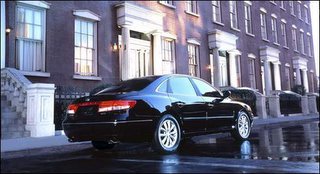 All Azeras come with smooth and silent five-speed automatics.
All Azeras come with smooth and silent five-speed automatics.
Suspension is also all-new, with double wishbones up front and independent multilinks in the rear. A Bosch-designed electronic stability control program helps keep the Azera from exceeding the laws of physics. While we didn’t push it, Azera felt more responsive than its predecessor. The handling is stately, formidable and safe, not lively. It might even be more tossable than an Avalon, though we didn’t drive the two back to back. It achieves the comfortable luxury setup that buyers expect.
Inside it was as quiet as a library and lacked nothing you’d expect in an entry luxury ride. Standard features include everything from rain-sensing wipers and power-adjustable pedals to remote locks with engine immobilizer and a power rear sunshade that retracts when you back up.
Is this the same company that sold Excels here just 15 or so years ago?
Azeras are available now.
Hyundai expects to sell between 30,000 and 40,000 a year, which is entirely doable once word gets out how cushy they really are. And with a 10-year warranty, what’s not to love? What are you looking for, prestige? Buy a hat!
Always remember to visit for latest deals available Gary Rome Hyundai , Hyundai Accessory Store and Hyundai Performance Auto Parts.
Monday, January 09, 2006
2007 Santa Fe Official USA site
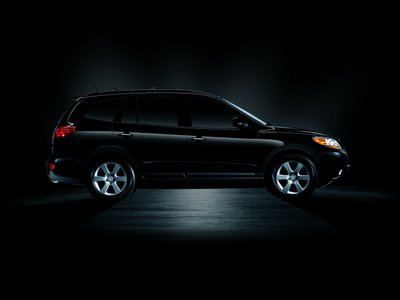
 CHOICE OF V6 ENGINES
Santa Fe will be available with a choice of two powerful and efficient V6 engines: the new 2.7-liter Mu and the modern 3.3-liter Lambda. The standard 2.7-liter V6 is upgraded for 2007 and now includes Variable Valve Timing and a Variable Intake System to produce more than 180 horsepower and 180 lb.-ft. of torque (preliminary estimates). This new 2.7-liter V6 produces more horsepower and torque than its predecessor, with improved fuel economy. The 3.3-liter Lambda V6 is lighter, more fuel efficient and cleaner burning than the previous-generation Santa Fe 3.5-liter V6, while producing an additional 30 horsepower. Preliminary output estimates are more than 230 horsepower and 220 lb.-ft. of torque.
CHOICE OF V6 ENGINES
Santa Fe will be available with a choice of two powerful and efficient V6 engines: the new 2.7-liter Mu and the modern 3.3-liter Lambda. The standard 2.7-liter V6 is upgraded for 2007 and now includes Variable Valve Timing and a Variable Intake System to produce more than 180 horsepower and 180 lb.-ft. of torque (preliminary estimates). This new 2.7-liter V6 produces more horsepower and torque than its predecessor, with improved fuel economy. The 3.3-liter Lambda V6 is lighter, more fuel efficient and cleaner burning than the previous-generation Santa Fe 3.5-liter V6, while producing an additional 30 horsepower. Preliminary output estimates are more than 230 horsepower and 220 lb.-ft. of torque.
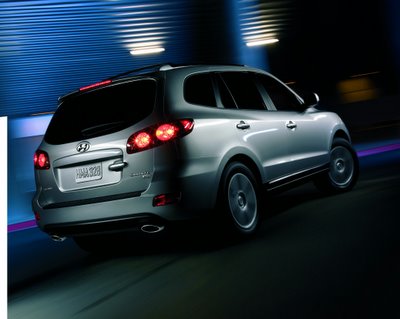
 SEGMENT-LEADING SAFETY
The all-new 2007 Santa Fe continues Hyundai's leadership in standardizing the industry's most effective safety technologies. The new Santa Fe features six standard airbags, including side air curtains for all three rows of seats. The combination of side and curtain airbags, which help protect the head and body during side impacts, can reduce fatalities by more than 45 percent, according to the Insurance Institute for Highway Safety (IIHS). Side curtain air protection is optional on many compact and mid-size SUVs, including Toyota RAV4, Toyota Highlander and Ford Explorer.
In addition, all Santa Fe trim levels come standard with Electronic Stability Control (ESC), one of the industry's most effective life-saving technologies. NHTSA studies show SUVs equipped with ESC experience 63 percent fewer fatalities in single-vehicle crashes. Santa Fe joins Tucson, Sonata, Azera, and Entourage as vehicles in Hyundai's growing lineup with standard Electronic Stability Control -- a commitment to this sophisticated and effective automotive safety technology that is unmatched by any other non-luxury automotive brand.
Front and rear disc brakes are standard and are coupled with a four-channel Anti-lock Braking System (ABS) that includes Electronic Brake force Distribution (EBD) to optimize brake performance even with differing vehicle loading.
SEGMENT-LEADING SAFETY
The all-new 2007 Santa Fe continues Hyundai's leadership in standardizing the industry's most effective safety technologies. The new Santa Fe features six standard airbags, including side air curtains for all three rows of seats. The combination of side and curtain airbags, which help protect the head and body during side impacts, can reduce fatalities by more than 45 percent, according to the Insurance Institute for Highway Safety (IIHS). Side curtain air protection is optional on many compact and mid-size SUVs, including Toyota RAV4, Toyota Highlander and Ford Explorer.
In addition, all Santa Fe trim levels come standard with Electronic Stability Control (ESC), one of the industry's most effective life-saving technologies. NHTSA studies show SUVs equipped with ESC experience 63 percent fewer fatalities in single-vehicle crashes. Santa Fe joins Tucson, Sonata, Azera, and Entourage as vehicles in Hyundai's growing lineup with standard Electronic Stability Control -- a commitment to this sophisticated and effective automotive safety technology that is unmatched by any other non-luxury automotive brand.
Front and rear disc brakes are standard and are coupled with a four-channel Anti-lock Braking System (ABS) that includes Electronic Brake force Distribution (EBD) to optimize brake performance even with differing vehicle loading.
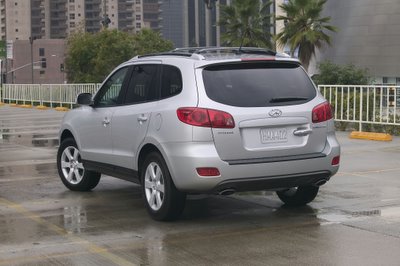
 BOLD DESIGN
With dramatic new styling that is assertive, refined and confident, the all-new Santa Fe exterior showcases the evolving face of the Hyundai brand. At 184.1 inches long, the new Santa Fe is about seven inches longer than its predecessor, one inch wider and almost two inches taller. Its 2.9-inch wider track -- wider than Toyota Highlander or Ford Explorer -- provides a strong stance, improved handling and increased interior room.
BOLD DESIGN
With dramatic new styling that is assertive, refined and confident, the all-new Santa Fe exterior showcases the evolving face of the Hyundai brand. At 184.1 inches long, the new Santa Fe is about seven inches longer than its predecessor, one inch wider and almost two inches taller. Its 2.9-inch wider track -- wider than Toyota Highlander or Ford Explorer -- provides a strong stance, improved handling and increased interior room.

 EFFICIENT INTERIOR
The all-new 2007 Santa Fe is one of the most package-efficient crossovers on the market. Hyundai accomplished this by developing an all-new platform that avoids the compromises inherent in typical mid-size car/SUV platform sharing. For example, although the 2007 Santa Fe is 2.1 inches shorter than the Lexus RX330, its first- and second-row seats have more head, leg, and shoulder room than the RX, with enough room left over to allow an optional third-row seat not available in the Lexus.
EFFICIENT INTERIOR
The all-new 2007 Santa Fe is one of the most package-efficient crossovers on the market. Hyundai accomplished this by developing an all-new platform that avoids the compromises inherent in typical mid-size car/SUV platform sharing. For example, although the 2007 Santa Fe is 2.1 inches shorter than the Lexus RX330, its first- and second-row seats have more head, leg, and shoulder room than the RX, with enough room left over to allow an optional third-row seat not available in the Lexus.
 ALL-NEW, PURPOSE-BUILT PLATFORM
The second-generation Santa Fe rides on an all-new, purpose-built unibody SUV platform with a 106.3-inch wheelbase that is 3.2 inches longer than its predecessor. This chassis was specifically designed to deliver more of the ride and handling balance that resonates with crossover shoppers. The 2007 Santa Fe achieves a 50-percent improvement in body bending rigidity over the prior model and is 59 percent stiffer than Toyota Highlander. This stiff body
structure provides a more refined sedan-like ride. Thanks to the new suspension geometry and wider track width (which enables greater turn angles), Hyundai engineers tightened Santa Fe's turning circle by nearly two feet -- an advantage Santa Fe drivers will appreciate in their daily driving.
ALL-NEW, PURPOSE-BUILT PLATFORM
The second-generation Santa Fe rides on an all-new, purpose-built unibody SUV platform with a 106.3-inch wheelbase that is 3.2 inches longer than its predecessor. This chassis was specifically designed to deliver more of the ride and handling balance that resonates with crossover shoppers. The 2007 Santa Fe achieves a 50-percent improvement in body bending rigidity over the prior model and is 59 percent stiffer than Toyota Highlander. This stiff body
structure provides a more refined sedan-like ride. Thanks to the new suspension geometry and wider track width (which enables greater turn angles), Hyundai engineers tightened Santa Fe's turning circle by nearly two feet -- an advantage Santa Fe drivers will appreciate in their daily driving.
 HYUNDAI VALUE
A well-equipped 2007 Santa Fe, with standard Electronic Stability Control, six airbags, anti-whiplash active front head restraints, tire pressure monitoring system, air conditioning, power windows, power locks, heated power mirrors, cruise control, AM/FM/CD/MP3 player, 16-inch aluminum wheels, dual exhausts and roof rack will be priced thousands of dollars below a
comparably-equipped Toyota Highlander, carrying on the Santa Fe tradition of exceptional value.
HYUNDAI VALUE
A well-equipped 2007 Santa Fe, with standard Electronic Stability Control, six airbags, anti-whiplash active front head restraints, tire pressure monitoring system, air conditioning, power windows, power locks, heated power mirrors, cruise control, AM/FM/CD/MP3 player, 16-inch aluminum wheels, dual exhausts and roof rack will be priced thousands of dollars below a
comparably-equipped Toyota Highlander, carrying on the Santa Fe tradition of exceptional value.
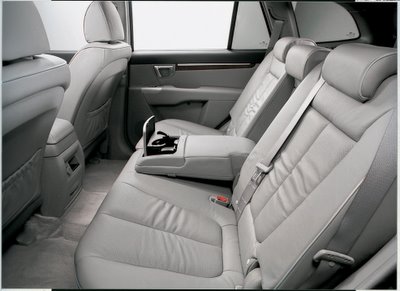 DOMESTIC PRODUCTION
The 2007 Santa Fe will be built at Hyundai Motor Manufacturing America (HMMA) in Montgomery, Ala. Production of the Santa Fe is scheduled to begin in the second quarter of 2006, with vehicles arriving in dealerships during summer. By the end of 2006, Hyundai will manufacture more than half of its total U.S. sales volume in Alabama.
DOMESTIC PRODUCTION
The 2007 Santa Fe will be built at Hyundai Motor Manufacturing America (HMMA) in Montgomery, Ala. Production of the Santa Fe is scheduled to begin in the second quarter of 2006, with vehicles arriving in dealerships during summer. By the end of 2006, Hyundai will manufacture more than half of its total U.S. sales volume in Alabama.
 HYUNDAI MOTOR AMERICA
Hyundai Motor America, headquartered in Fountain Valley, Calif., is a subsidiary of Hyundai Motor Co. of Korea. Hyundai vehicles are distributed throughout the United States by Hyundai Motor America and are sold and serviced through 695 dealerships nationwide.
Source: Hyundai Motor America
Always remember to visit for latest deals available Gary Rome Hyundai , Hyundai Accessory Store and Hyundai Performance Auto Parts.
HYUNDAI MOTOR AMERICA
Hyundai Motor America, headquartered in Fountain Valley, Calif., is a subsidiary of Hyundai Motor Co. of Korea. Hyundai vehicles are distributed throughout the United States by Hyundai Motor America and are sold and serviced through 695 dealerships nationwide.
Source: Hyundai Motor America
Always remember to visit for latest deals available Gary Rome Hyundai , Hyundai Accessory Store and Hyundai Performance Auto Parts.
ROAD & TRAVEL Magazine Announces 2006 International Car of the Year Awards Winners
Thursday, January 05, 2006
2006 Hyundai Sonata VentVisors now available
Features
- Install w/ OEM-approved 3M Adhesive Foam Tape
- Keeps The Rain Out
- Lets Fresh Air In
- Reduces Heat Build-Up In Cab
- Windows Can Be Left Partially Open
- No Drill Installation
- Made Of Reinforced Acrylic
- Attractive Dark Smoke Gray
Special Hyundai Accessory Store price of $89.99
Register at Hyundai Accessory Store now and recieve an additional 11% off your purchase!
All Auto VentShade products come with a limited lifetime warranty* and their commitment is for your complete satisfaction. Auto VentShade products have been protecting and styling vehicles since 1935. They know how important it is to protect your valuable investment, so that's why they design products that are both functional and look cool. Made of a rugged impact-modified acrylic, they install quickly and easily with 3M Acrylic Foam Tape. Auto Ventshade is quality QS-9000/ISO 9001 certified for the design, manufacturing and distribution of Automotive Accessories. *For warranty information please see lundinternational.com Always remember to visit for latest deals available Gary Rome Hyundai , Hyundai Accessory Store and Hyundai Performance Auto Parts.
2007 Hyundai Santa Fe: Comming Soon
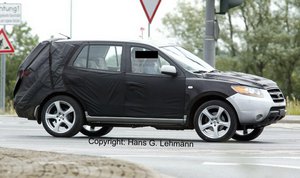 Spy Shots: ’07 Hyundai Santa Fe
Coming to America, the long way.
by Hans Lehmann/Hidden Image
(2005-07-11)
thecarconnection.com
Hyundai has been on a new-product blitz, bringing to market one new vehicle after another. So far Hyundai has introduced the Tucson and the Sonata, and has put out official information on the Azera.
Still to come is an all-new Hyundai Santa Fe sport-utility vehicle. These photos capture a prototype Santa Fe without any front-bumper disguise, thus giving us a clear view of the SUV's new looks.
With the new Hyundai Tucson filling the role of compact SUV in the model lineup, Hyundai is now free to grow a larger Santa Fe and move it up a size class to compete with larger SUVs like the Nissan Murano and Toyota Highlander. The increased size will allow the Santa Fe to have a third row of seats for the first time.
The new Santa Fe will be built on a platform that is shared with the new Hyundai Sonata sedan, and the Santa Fe will also be built in Hyundai's new plant in Montgomery, Alabama.
Styling is fresh and ditches the voluptuous looks of the current Santa Fe in favor of a look with a large, forward-sloping grille. The rounded shape of the front end gives the new Santa Fe a unique design by eliminating the typical protruding bumper used on every other SUV.
Spy Shots: ’07 Hyundai Santa Fe
Coming to America, the long way.
by Hans Lehmann/Hidden Image
(2005-07-11)
thecarconnection.com
Hyundai has been on a new-product blitz, bringing to market one new vehicle after another. So far Hyundai has introduced the Tucson and the Sonata, and has put out official information on the Azera.
Still to come is an all-new Hyundai Santa Fe sport-utility vehicle. These photos capture a prototype Santa Fe without any front-bumper disguise, thus giving us a clear view of the SUV's new looks.
With the new Hyundai Tucson filling the role of compact SUV in the model lineup, Hyundai is now free to grow a larger Santa Fe and move it up a size class to compete with larger SUVs like the Nissan Murano and Toyota Highlander. The increased size will allow the Santa Fe to have a third row of seats for the first time.
The new Santa Fe will be built on a platform that is shared with the new Hyundai Sonata sedan, and the Santa Fe will also be built in Hyundai's new plant in Montgomery, Alabama.
Styling is fresh and ditches the voluptuous looks of the current Santa Fe in favor of a look with a large, forward-sloping grille. The rounded shape of the front end gives the new Santa Fe a unique design by eliminating the typical protruding bumper used on every other SUV.
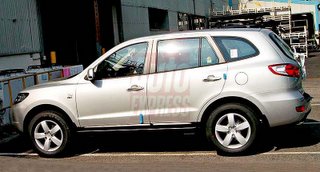 Bigger is better for Santa FE
Tuesday 15th November 2005
autoexpress.co.uk
Christmas has come early at Auto Express - our spy photographers have caught Santa Fe on film. This amazing picture reveals Hyundai's all-new SUV totally undisguised and ready for the road, months ahead of its official launch.
Left exposed in broad daylight, the new Santa Fe's sleek lines are a radical departure from the bulbous look of the existing version, and help take the model upmarket. Set to go on sale in the UK next autumn, the 4x4 will be available with a choice of petrol and diesel engines. And the VGT - Variable Geometry Turbo - badge on the side of this car reveals it's the 2.2-litre oil-burner, which is likely to be the top seller.
The new Santa Fe will be larger than the outgoing model in order to widen the gap between
it and the smaller Tucson. The extra size has allowed engineers to fit a versatile seven-seat interior - making the off-roader a viable alternative to a full-size MPV.
Expect plenty of equipment as standard, too, while Hyundai's pioneering five-year warranty will also be a major selling point. Prices have yet to be finalised, but more details are likely to be announced closer to the car's official unveiling at the Geneva Motor Show in March next year.
Following the launch of the Santa Fe, Hyundai will then turn its attention to its larger 4x4s.
While the Terracan will continue unchanged until at least 2008, a new big off-roader is already being developed in the US to offer a cut-price alternative to Land Rover's Discovery.
Chris Thorp
Bigger is better for Santa FE
Tuesday 15th November 2005
autoexpress.co.uk
Christmas has come early at Auto Express - our spy photographers have caught Santa Fe on film. This amazing picture reveals Hyundai's all-new SUV totally undisguised and ready for the road, months ahead of its official launch.
Left exposed in broad daylight, the new Santa Fe's sleek lines are a radical departure from the bulbous look of the existing version, and help take the model upmarket. Set to go on sale in the UK next autumn, the 4x4 will be available with a choice of petrol and diesel engines. And the VGT - Variable Geometry Turbo - badge on the side of this car reveals it's the 2.2-litre oil-burner, which is likely to be the top seller.
The new Santa Fe will be larger than the outgoing model in order to widen the gap between
it and the smaller Tucson. The extra size has allowed engineers to fit a versatile seven-seat interior - making the off-roader a viable alternative to a full-size MPV.
Expect plenty of equipment as standard, too, while Hyundai's pioneering five-year warranty will also be a major selling point. Prices have yet to be finalised, but more details are likely to be announced closer to the car's official unveiling at the Geneva Motor Show in March next year.
Following the launch of the Santa Fe, Hyundai will then turn its attention to its larger 4x4s.
While the Terracan will continue unchanged until at least 2008, a new big off-roader is already being developed in the US to offer a cut-price alternative to Land Rover's Discovery.
Chris Thorp
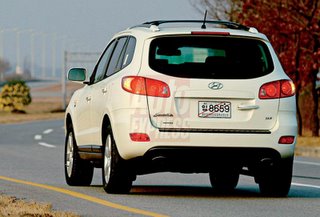
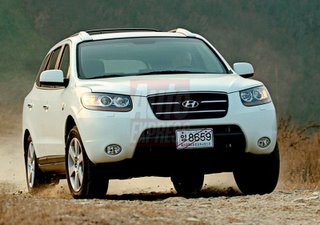 Hyundai Santa Fe
December 2005
autoexpress.co.uk
Getting established in the SUV market isn't easy - just ask Hyundai! The firm already has three 4x4s in its line-up, but only the entry-level Tucson is capable of challenging for class honours.
That's a situation the all-new Santa Fe hopes to change. Designers have banished memories of the current bulbous and ungainly machine to the history books, and instead have created a distinctive looking five-door SUV.
Inside, the makeover is almost as striking, but although the cabin has a more upmarket feel, and for the first time seven seats, the plastics still appear cheap. As with the Sonata saloon, the Santa Fe has a prominent centre console, but the layout has been brought up-to-date.
While a 2.7-litre V6 petrol variant will be available, the 151bhp 2.2-litre diesel driven here should account for most sales in the UK. Replacing the outgoing 2.0-litre oil-burner, the new unit delivers an extra 36bhp and an impressive 343Nm of torque.
From a standstill, the diesel engine is a little unresponsive, but once on the move it provides smooth acceleration whether mated to manual or automatic gearboxes. A part-time four-wheel-drive transmission system also ensures the Santa Fe is never short of traction, as it feeds power to the rear wheels when the front tyres slip.
Engineers have fitted stiffer suspension to the new model, and as a result the Santa Fe doesn't offer as smooth a ride as the class-leaders. The benefit comes in the corners, where body roll is more controlled and handling is impressive in all but the tightest of bends. Safety hasn't been forgotten either, with six airbags, EBS, ABS, traction control and active headrests all available. Prices are expected to rise over the current version, with the line-up likely to start at around £21,000.
We'll have to wait until we drive the Santa Fe in European specification to see if Hyundai has got a potential class-leader in its ranks, but the early impressions are encouraging.
Charley Chae
Hyundai Santa Fe
December 2005
autoexpress.co.uk
Getting established in the SUV market isn't easy - just ask Hyundai! The firm already has three 4x4s in its line-up, but only the entry-level Tucson is capable of challenging for class honours.
That's a situation the all-new Santa Fe hopes to change. Designers have banished memories of the current bulbous and ungainly machine to the history books, and instead have created a distinctive looking five-door SUV.
Inside, the makeover is almost as striking, but although the cabin has a more upmarket feel, and for the first time seven seats, the plastics still appear cheap. As with the Sonata saloon, the Santa Fe has a prominent centre console, but the layout has been brought up-to-date.
While a 2.7-litre V6 petrol variant will be available, the 151bhp 2.2-litre diesel driven here should account for most sales in the UK. Replacing the outgoing 2.0-litre oil-burner, the new unit delivers an extra 36bhp and an impressive 343Nm of torque.
From a standstill, the diesel engine is a little unresponsive, but once on the move it provides smooth acceleration whether mated to manual or automatic gearboxes. A part-time four-wheel-drive transmission system also ensures the Santa Fe is never short of traction, as it feeds power to the rear wheels when the front tyres slip.
Engineers have fitted stiffer suspension to the new model, and as a result the Santa Fe doesn't offer as smooth a ride as the class-leaders. The benefit comes in the corners, where body roll is more controlled and handling is impressive in all but the tightest of bends. Safety hasn't been forgotten either, with six airbags, EBS, ABS, traction control and active headrests all available. Prices are expected to rise over the current version, with the line-up likely to start at around £21,000.
We'll have to wait until we drive the Santa Fe in European specification to see if Hyundai has got a potential class-leader in its ranks, but the early impressions are encouraging.
Charley Chae
____________________________________________________ Note: the above information was taken from a UK web site. The Diesel and turbo engines will most likely not be available in the USA. The USA 2007 Hyundai Santa Fe will most likey see the 3.3V6 currently used in the 2006 Hyundai Sonata or the 3.8 V6 currently used in the 2006 Hyundai Azera. The redesigned 2.4L 4 cylinder, currently used in the 2006 Hyundai Sonata, may also make its way in to the 2007 Hyundai Santa Fe. ____________________________________________________
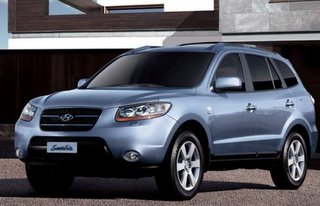
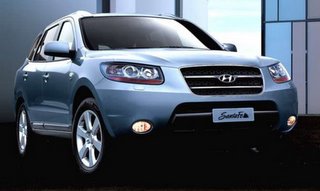


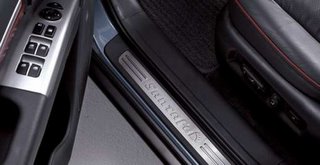
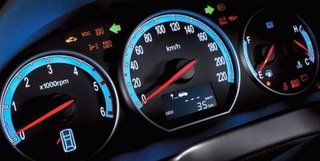
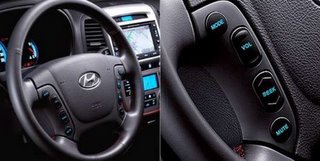

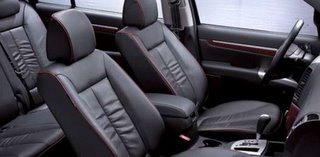
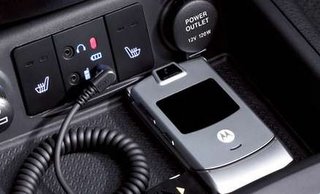

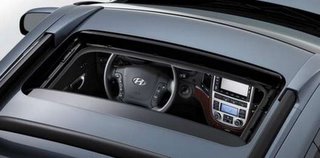 2007 Hyundai Santa Fe launches in Korea
Posted Nov 22nd 2005 3:30PM by Stuart Waterman
Filed under: SUVs
autoblog.com
Little information other than what we can glean from the pictures, but what we can see shows that the new Santa Fe is a huge improvement over the current version. Hyundai's Santa Fe-dedicated website is here (warning - lots of Flash). Autoblog reader Source1 reports that a Hyundai dealer told him that we can expect two engines, a 3.3-liter putting out 240-250 hp, and a 3.8-liter with 275-285 hp. Much more after the jump!
2007 Hyundai Santa Fe launches in Korea
Posted Nov 22nd 2005 3:30PM by Stuart Waterman
Filed under: SUVs
autoblog.com
Little information other than what we can glean from the pictures, but what we can see shows that the new Santa Fe is a huge improvement over the current version. Hyundai's Santa Fe-dedicated website is here (warning - lots of Flash). Autoblog reader Source1 reports that a Hyundai dealer told him that we can expect two engines, a 3.3-liter putting out 240-250 hp, and a 3.8-liter with 275-285 hp. Much more after the jump!
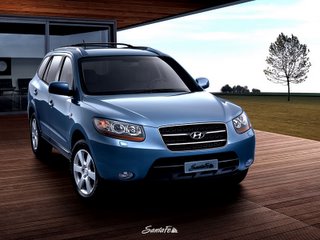
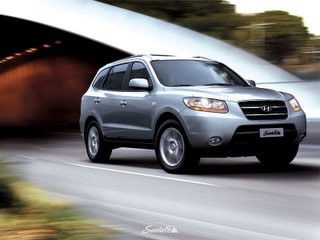
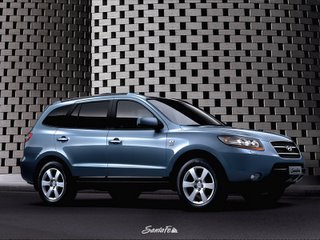
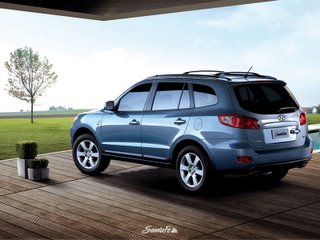

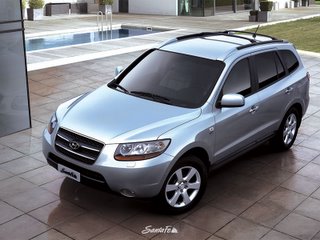
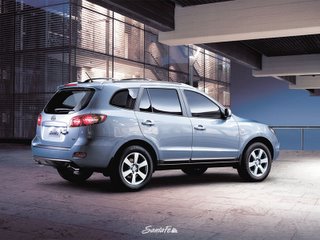
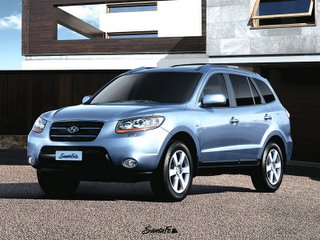
 Always remember to visit for latest deals available Gary Rome Hyundai , Hyundai Accessory Store and Hyundai Performance Auto Parts.
Always remember to visit for latest deals available Gary Rome Hyundai , Hyundai Accessory Store and Hyundai Performance Auto Parts.

